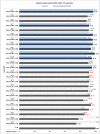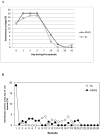Efficacy and safety of fixed-dose artesunate-amodiaquine vs. artemether-lumefantrine for repeated treatment of uncomplicated malaria in Ugandan children
- PMID: 25436614
- PMCID: PMC4249977
- DOI: 10.1371/journal.pone.0113311
Efficacy and safety of fixed-dose artesunate-amodiaquine vs. artemether-lumefantrine for repeated treatment of uncomplicated malaria in Ugandan children
Abstract
The safety and efficacy of the two most widely used fixed-dose artemisinin-based combination therapies (ACT), artesunate-amodiaquine (ASAQ) and artemether-lumefantrine (AL) are well established for single episodes of uncomplicated Plasmodium falciparum malaria, but the effects of repeated, long-term use are not well documented. We conducted a 2-year randomized, open-label, longitudinal, phase IV clinical trial comparing the efficacy and safety of fixed-dose ASAQ and AL for repeated treatment of uncomplicated malaria in children under 5 years at Nagongera Health Centre, Uganda. Participants were randomized to ASAQ or AL and all subsequent malaria episodes were treated with the same regimen. 413 children were enrolled and experienced a total of 6027 malaria episodes (mean 15; range, 1-26). For the first malaria episode, the PCR-corrected-cure rate for ASAQ (97.5%) was non-inferior to that for AL (97.0%; 95% CI [-0.028; 0.037]). PCR-corrected cure rates for subsequent malaria episodes that had over 100 cases (episodes 2-18), ranged from 88.1% to 98.9% per episode, with no clear difference between the treatment arms. Parasites were completely cleared by day 3 for all malaria episodes and gametocyte carriage was less than 1% by day 21. Fever clearance was faster in the ASAQ group for the first episode. Treatment compliance for subsequent episodes (only first dose administration observed) was close to 100%. Adverse events though common were similar between treatment arms and mostly related to the disease. Serious adverse events were uncommon, comparable between treatment arms and resolved spontaneously. Anemia and neutropenia occurred in <0.5% of cases per episode, abnormal liver function tests occurred in 0.3% to 1.4% of cases. Both regimens were safe and effective for repeated treatment of malaria.
Trial registration: Current Controlled Trials NCT00699920.
Conflict of interest statement
Figures








References
-
- WHO (2012) World malaria report 2012, World Health Organization, 2012. Available: www.who.int/malaria/publications/world_malaria_report_2012/en/.
-
- Gbotosho GO, Sowunmi A, Okuboyejo TM, Happi CT, Folarin OO, et al. (2012) A simple dose regimen of artesunate and amodiaquine based on age or body weight range for uncomplicated falciparum malaria in children: comparison of therapeutic efficacy with standard dose regimen of artesunate and amodiaquine and artemether-lumefantrine. Am J Ther 19:e122–e131 10.1097/MJT.0b013e318209e031 [doi] - DOI - PubMed
-
- WHO (2011) World Health organisation, WHO Model List of. Essential Medicines for Children. 3rd list. (March 2011); available at whqlibdoc.who.int/hq/2011/a95054_eng.pdf, accessed January 2014.
Publication types
MeSH terms
Substances
Associated data
LinkOut - more resources
Full Text Sources
Other Literature Sources
Medical

